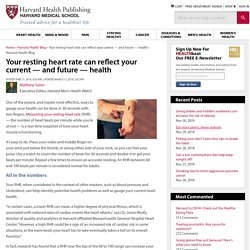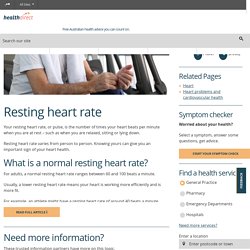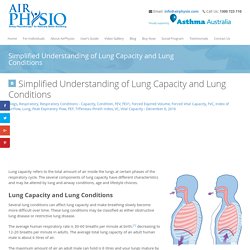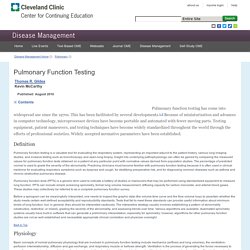

Better Health Channel - Home. Mayo Clinic. MedlinePlus - Health Information from the National Library of Medicine. Health information online. Your resting heart rate can reflect your current — and future — health - Harvard Health Blog - Harvard Health Publishing. One of the easiest, and maybe most effective, ways to gauge your health can be done in 30 seconds with two fingers.

Measuring your resting heart rate (RHR) — the number of heart beats per minute while you’re at rest — is a real-time snapshot of how your heart muscle is functioning. It’s easy to do. Place your index and middle finger on your wrist just below the thumb, or along either side of your neck, so you can feel your pulse. Use a watch to count the number of beats for 30 seconds and double it to get your beats per minute.
Repeat a few times to ensure an accurate reading. All in the numbers Your RHR, when considered in the context of other markers, such as blood pressure and cholesterol, can help identify potential health problems as well as gauge your current heart health. “In certain cases, a lower RHR can mean a higher degree of physical fitness, which is associated with reduced rates of cardiac events like heart attacks,” says Dr. MyDr.com.au - Health and Medical Information for Australia. Target Heart Rates. Resting heart rate. Your resting heart rate, or pulse, is the number of times your heart beats per minute when you are at rest – such as when you are relaxed, sitting or lying down.

Resting heart rate varies from person to person. Knowing yours can give you an important sign of your heart health. What is a normal resting heart rate? For adults, a normal resting heart rate ranges between 60 and 100 beats a minute. Usually, a lower resting heart rate means your heart is working more efficiently and is more fit. For example, an athlete might have a resting heart rate of around 40 beats a minute. How do I check my resting heart rate? To check your heart rate: Sit down and rest for 5 minutes.Turn your wrist so your palm is facing up.Then feel for a pulse at thumb side of your wrist.Once you feel it, count how many times you feel a beat in 30 seconds.
If you can’t find your pulse at your wrist, put two fingers on the side of your neck, next to the windpipe. Target Heart Rate Calculator. Simplified Understanding of Lung Capacity and Lung Conditions. Lung capacity refers to the total amount of air inside the lungs at certain phases of the respiratory cycle.

The several components of lung capacity have different characteristics and may be altered by lung and airway conditions, age and lifestyle choices. Lung Capacity and Lung Conditions Several lung conditions can affect lung capacity and make breathing slowly become more difficult over time. These lung conditions may be classified as either obstructive lung disease or restrictive lung disease. The average human respiratory rate is 30-60 breaths per minute at birth,[1] decreasing to 12-20 breaths per minute in adults. The maximum amount of air an adult male can hold is 6 litres and your lungs mature by the time you are about 20-25 years old. Obstructive Lung Disease People with obstructive lung disease have airflow limitation due to inability to completely expel air from the lungs. In obstructive lung disease, the FEV1 is reduced due to an obstruction of air escaping from the lungs. Pulmonary Function Testing.
Pulmonary function testing has come into widespread use since the 1970s.

This has been facilitated by several developments.1,2 Because of miniaturization and advances in computer technology, microprocessor devices have become portable and automated with fewer moving parts. Testing equipment, patient maneuvers, and testing techniques have become widely standardized throughout the world through the efforts of professional societies. Widely accepted normative parameters have been established.
Definition Pulmonary function testing is a valuable tool for evaluating the respiratory system, representing an important adjunct to the patient history, various lung imaging studies, and invasive testing such as bronchoscopy and open-lung biopsy. Pulmonary function tests (PFTs) is a generic term used to indicate a battery of studies or maneuvers that may be performed using standardized equipment to measure lung function. Back to Top Physiology Battery of maneuvers Spirometry Forced Vital Capacity Equipment. RC Euro Repiratory Monograph Chapter 9 WP EN. Open Learning Initiative: Register for a Course.